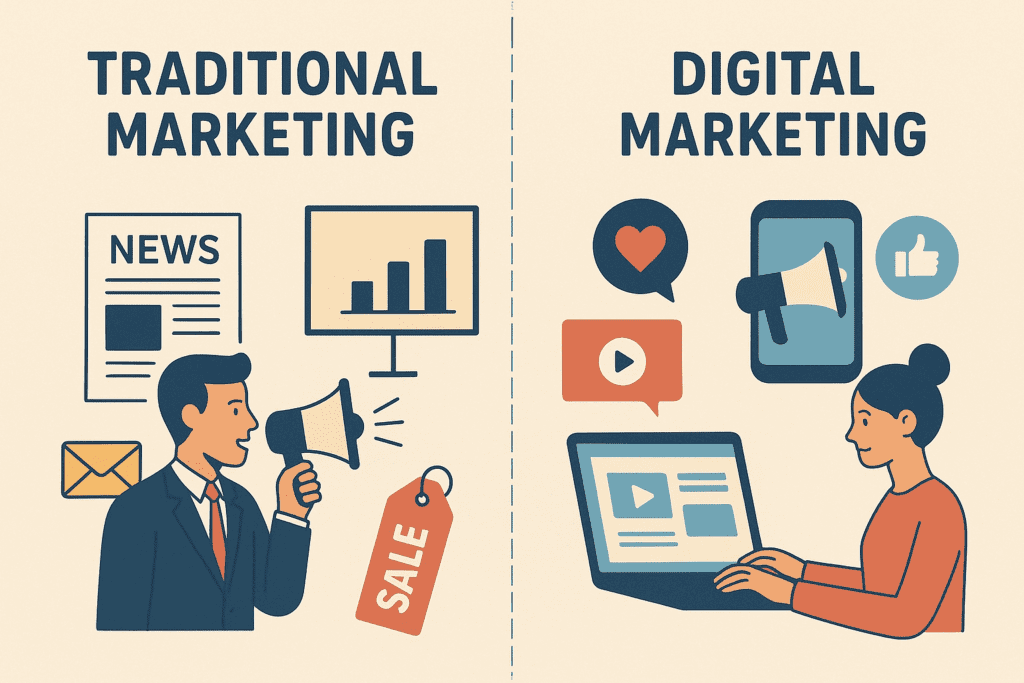Traditional Marketing vs Digital Marketing 2025: Complete Comparison Guide
In today’s rapidly evolving business landscape, effective marketing is the base for for brands growth and sustainable success. As technology advances and consumer behaviors shift, a fundamental question arises for entrepreneurs and business owners: “Which marketing approach yields better results—traditional marketing or digital marketing in 2025?”
While both strategies possess unique strengths and applications, a comprehensive understanding of their distinctions, advantages, and optimal use cases is crucial for maximizing your marketing return on investment (ROI). This in-depth comparison guide will navigate the intricacies of traditional versus digital marketing, providing actionable insights to help you make informed decisions for your business.


Table of Contents
ToggleWhat You’ll Learn in This Guide:
- Traditional marketing methods and their core applications
- Digital marketing strategies and modern channels
- Cost comparison and ROI analysis between both approaches
- When to use traditional vs digital marketing for maximum impact
Ready to optimize your marketing strategy for 2025? Let’s dive into this complete comparison.
Primary Traditional Marketing Channels:
1. Television Commercials
- High-reach visual and auditory advertisements with broad demographic appeal
- Ideal for brand awareness campaigns and emotional storytelling
- Average cost: $5,000 – $500,000+ per campaign
2. Print Media Marketing
- Newspaper and magazine advertisements targeting specific demographics and interests
- Includes local newspapers, industry publications, and lifestyle magazines
- Cost range: $1,000 – $20,000 per placement
3. Radio Advertising
- Audio advertisements reaching listeners during daily routines and commutes
- Effective for local businesses and time-sensitive promotions
- Monthly investment: $500 – $5,000
4. Direct Mail Marketing
- Personalized physical mail campaigns sent directly to potential customers
- Includes postcards, catalogs, and promotional flyers
- Cost per piece: $0.50 – $3.00
5. Outdoor Advertising
- Billboards, transit ads, and signage for widespread brand exposure
- High visibility in high-traffic areas
- Monthly rates: $2,000 – $15,000
6. Event Marketing
- Trade shows, conferences, and local community events
- Face-to-face networking and relationship building
- Variable costs based on event size and location
These conventional marketing techniques remain highly effective for local business marketing, building brand recognition, and engaging demographics who prefer offline interactions.
Primary Digital Marketing Channels
Digital marketing leverages online platforms and internet-connected devices to promote products and services, offering unparalleled targeting capabilities and measurable results. This dynamic field includes diverse strategies that have revolutionized how businesses connect with their audiences in 2025.
1. Search Engine Optimization (SEO)
- Optimizing online content to rank higher in search engine results pages (SERPs)
- Long-term strategy for organic visibility and traffic
- Monthly investment: $500 – $5,000
2. Pay-Per-Click Advertising (PPC)
- Paid campaigns on Google Ads, Bing Ads, and social media platforms
- Immediate results with precise targeting options
- Budget range: $1,000 – $10,000+ per month
3. Social Media Marketing
- Engaging audiences on Facebook, Instagram, LinkedIn, TikTok, and Twitter
- Community building and brand personality development
- Monthly costs: $500 – $5,000
4. Content Marketing
- Creating valuable blogs, videos, podcasts, and guides to attract and retain customers
- Establishes thought leadership and builds trust
- Investment: $500 – $3,000 per month
5. Email Marketing
- Building customer relationships through targeted email campaigns and automation
- Highest ROI potential: up to 42:1 return
- Monthly cost: $20 – $500
6. Influencer Marketing
- Partnering with influential individuals to promote products and services
- Leverages trust and credibility of established personalities
- Variable costs based on influencer reach
7. Video Marketing
- Leveraging YouTube, social media videos, and webinars for engagement
- Highest engagement rates across all content types
- Production costs vary widely
The digital marketing landscape continues evolving rapidly, with emerging trends like AI-powered personalization, voice search optimization, and interactive content shaping the future of online marketing.
Traditional Marketing vs Digital Marketing: Complete Comparison
Here’s a detailed comparison of traditional and digital marketing across key business factors:
Feature | Traditional Marketing | Digital Marketing |
Primary Channels | TV, Radio, Print, Outdoor, Direct Mail | SEO, Social Media, Email, PPC, Content |
Geographic Reach | Local to regional focus | Global reach with local targeting |
Cost Structure | High upfront investment, fixed costs | Flexible budgets, scalable spending |
Audience Targeting | Broad demographic targeting | Hyper-targeted (behavior, interests, location) |
Measurability | Difficult to track ROI accurately | Real-time analytics and detailed reporting |
Engagement Type | One-way communication | Interactive, two-way engagement |
Campaign Speed | Weeks to months for launch | Instant publishing and rapid adjustments |
Lifespan | Longer campaign durations | Continuous optimization and updates |
Customer Interaction | Limited direct feedback | Comments, shares, direct messages |
Trust Building | Established credibility | Requires consistent effort to build trust |
Cost Analysis and ROI: Traditional vs Digital Marketing
Understanding the financial implications of each marketing approach is crucial for budget allocation and strategy planning in 2025.
Traditional Marketing Costs (Average Ranges):
- Television Ads: $5,000 – $500,000+ per campaign
- Radio Spots: $500 – $5,000 per month
- Print Advertising: $1,000 – $20,000 per placement
- Billboard Advertising: $2,000 – $15,000 per month
- Direct Mail: $0.50 – $3.00 per piece
Digital Marketing Costs (Average Ranges):
- SEO Services: $500 – $5,000 per month
- Google Ads: $1,000 – $10,000+ per month
- Social Media Advertising: $500 – $5,000 per month
- Email Marketing: $20 – $500 per month
- Content Creation: $500 – $3,000 per month
ROI Comparison Statistics:
- Traditional marketing average ROI: 3:1 to 5:1
- Digital marketing average ROI: 4:1 to 10:1+
- Email marketing ROI: Up to 42:1 (highest performing channel)
- Social media marketing ROI: 6:1 to 8:1 average
- Content marketing ROI: 3x more leads than traditional marketing
Key Insight: Digital marketing consistently delivers higher ROI due to better targeting, real-time optimization, and lower entry costs.

Benefits and Drawbacks: Traditional Marketing
✅ Advantages of Traditional Marketing
- Local Market Dominance: Highly effective for establishing strong presence in specific geographic areas
- High Brand Visibility: Channels like television and billboards offer massive exposure opportunities
- Tangible Marketing Materials: Physical assets create lasting impressions and brand recall
- Trust and Credibility: Traditional methods foster familiarity, especially with older demographics
- Less Digital Noise: Stands out in an increasingly crowded online space
- Broad Reach: Captures audiences who may not be active online
❌ Disadvantages of Traditional Marketing
High Costs with Limited Targeting: Expensive with less precise audience segmentation capabilities
- Difficult ROI Measurement: Challenging to quantify direct impact and return on investment
- Limited Audience Interaction: Lacks mechanisms for immediate customer feedback and engagement
- Slower Campaign Adaptation: Requires significant time and resources for modifications
- Declining Audience: Younger demographics increasingly favor digital channels
- Environmental Concerns: Print materials contribute to waste and environmental impact
Benefits and Drawbacks: Digital Marketing
Advantages of Digital Marketing
- Precise Audience Targeting: Advanced capabilities for reaching specific demographics, interests, and behaviors
- Measurable Results: Comprehensive analytics provide detailed insights into campaign performance
- Budget Flexibility: Scalable spending with options for businesses of all sizes
- Global Reach: Ability to connect with audiences worldwide while maintaining local relevance
- 24/7 Availability: Campaigns run continuously, capturing leads around the clock
- Real-time Optimization: Immediate adjustments based on performance data
- Interactive Engagement: Two-way communication builds stronger customer relationships
Disadvantages of Digital Marketing
- High Competition: Saturated markets require sophisticated strategies to stand out
- Constant Evolution: Requires continuous learning and adaptation to new platforms and algorithms
- Technical Complexity: Demands expertise in multiple tools and platforms
- Ad Fatigue: Audiences can become overwhelmed by digital advertising
- Privacy Concerns: Increasing regulations affect targeting and data collection
- Platform Dependency: Algorithm changes can significantly impact campaign performance
When to use which type of Marketing?
🎯 Choose Traditional Marketing When:
- Target Audience: Primarily older demographics (45+) who consume traditional media
- Geographic Focus: Hyper-local businesses serving specific communities
- Budget Availability: Substantial offline advertising budget with long-term commitment
- Industry Type: Professional services, healthcare, legal, or luxury goods
- Brand Awareness Goals: Building broad recognition in established markets
- Event-Based Marketing: Promoting local events, grand openings, or seasonal campaigns
💻 Choose Digital Marketing When:
- Target Audience: Younger demographics (18-45) who are digitally active
- Business Type: E-commerce, SaaS, online services, or tech startups
- Budget Constraints: Limited budget requiring measurable, scalable results
- Global Expansion: Targeting audiences beyond local geographic boundaries
- B2B Marketing: Reaching decision-makers through professional networks
- Rapid Growth Goals: Scaling quickly with data-driven optimization
Creating an Integrated/Hybrid Marketing Strategy
The most successful brands in 2025 employ a hybrid approach, combining traditional and digital marketing tactics to maximize impact and reach diverse audiences effectively.
🚀 Successful Integration Examples:
- QR Code Campaigns: Traditional print ads featuring QR codes linking to digital experiences
- Cross-Platform Storytelling: Consistent messaging across TV, radio, social media, and online content
- Event Marketing + Digital: Live events promoted through social media with real-time engagement
- Retargeting Integration: Traditional awareness campaigns followed by digital retargeting
- Omnichannel Customer Journey: Seamless experience from offline discovery to online purchase
📊 Integration Best Practices:
- Consistent Brand Messaging: Maintain unified voice and visual identity across all channels
- Data Integration: Combine offline and online analytics for comprehensive insights
- Customer Journey Mapping: Understand how customers interact with multiple touchpoints
- Budget Allocation: Strategic distribution between traditional and digital channels (typically 60% digital, 40% traditional in 2025)
- Performance Measurement: Establish metrics that capture both offline and online impact
Advanced SEO Strategies for Digital Marketing Success
Search engine optimization remains crucial for digital marketing success in 2025. Here are advanced techniques to boost your online visibility:
🔧 Technical SEO Foundations:
- Page Speed Optimization: Ensure loading times under 3 seconds for optimal user experience
- Mobile-First Design: Responsive design that prioritizes mobile user experience
- Core Web Vitals: Optimize for Google’s performance metrics (LCP, FID, CLS)
- Schema Markup: Implement structured data for enhanced search result appearance
- HTTPS Security: Ensure secure connections for all website pages
📝 Content Optimization Strategies:
- Long-tail Keywords: Target specific, less competitive phrases for higher conversion rates
- Topic Clustering: Create comprehensive content hubs around main topics
- User Intent Matching: Align content with search intent (informational, navigational, transactional)
- E-A-T Optimization: Establish expertise, authority, and trustworthiness through quality content
- Featured Snippets: Optimize content for position zero in search results
📍 Local SEO for Traditional-Digital Integration:
- Google My Business: Optimize local listings with accurate information and reviews
- Local Content: Create location-specific content for geographic targeting
- Citation Building: Ensure consistent NAP (Name, Address, Phone) across directories
- Local Link Building: Partner with local businesses and organizations for backlinks
- Local Schema: Implement local business schema markup
Conclusion: Choosing Your Marketing Strategy for 2025
As we navigate the evolving marketing landscape of 2025, the choice between traditional and digital marketing isn’t about selecting one over the other—it’s about understanding how each approach can contribute to your overall business success.
🎯 Key Takeaways:
- Digital marketing continues to dominate with its precision targeting, measurable results, and cost-effectiveness
- Traditional marketing maintains its strength in local markets and reaching offline-preferring audiences
- Integrated strategies combining both approaches deliver the highest ROI and broadest reach
- Budget allocation should typically favor digital (60%) over traditional (40%) for most businesses in 2025
🚀 Next Steps: Elevate Your Marketing Strategy
Ready to optimize your marketing approach for 2025? Consider these actionable steps:
Audit Your Current Strategy:
Evaluate your existing marketing mix and identify gaps
- Define Your Target Audience: Understand where your customers consume content and make decisions
- Set Clear Goals: Establish measurable objectives for both brand awareness and conversion
- Test and Optimize: Start with small campaigns in both traditional and digital channels
- Invest in Analytics: Implement tracking systems to measure performance across all channels
- Consider Professional Help: Partner with experienced marketing professionals for strategic guidance
Whether you focus on traditional methods, embrace digital innovation, or combine both approaches, the key to marketing success remains consistent: connect with the right audience, deliver valuable messaging, and continuously optimize based on results.
Remember: The best marketing strategy is one that aligns with your business goals, resonates with your target audience, and delivers measurable results within your budget constraints.
FAQs: Traditional Marketing vs Digital Marketing
Digital marketing is better than traditional marketing for most businesses in 2025 due to superior ROI (4:1 to 10:1), precise targeting capabilities, and real-time measurable results. However, the best approach often combines both strategies for maximum impact.
Traditional marketing uses offline channels like TV, radio, and print media for broad reach, while digital marketing leverages online platforms for targeted, interactive campaigns with detailed analytics and lower costs.
Digital marketing costs range from $500-$10,000 monthly versus traditional marketing's $5,000-$500,000 upfront investment. Digital marketing is significantly more budget-friendly and scalable for businesses of all sizes.
Digital marketing strategy delivers 4:1 to 10:1 ROI compared to traditional marketing's 3:1 to 5:1 ROI. Email marketing specifically can achieve up to 42:1 ROI, making digital marketing the clear winner for return on investment.
Best digital marketing channels include SEO, social media marketing, and email marketing for precise targeting. Traditional marketing channels like TV and radio offer broader reach but with less targeting precision and higher costs.
Small businesses should prioritize digital marketing over traditional marketing due to cost-effectiveness, precise targeting, measurable results, and lower barrier to entry. Digital marketing allows small businesses to compete with larger competitors on a level playing field.
Digital marketing advantages include real-time analytics, global reach with local targeting, lower costs, precise audience segmentation, 24/7 availability, and interactive engagement compared to traditional marketing's board, one-way approach.
Yes, integrating traditional and digital marketing through hybrid strategies like QR codes in print ads, cross-platform campaigns, and omnichannel customer journeys maximizes overall marketing effectiveness and reaches diverse audiences across multiple touchpoints.


